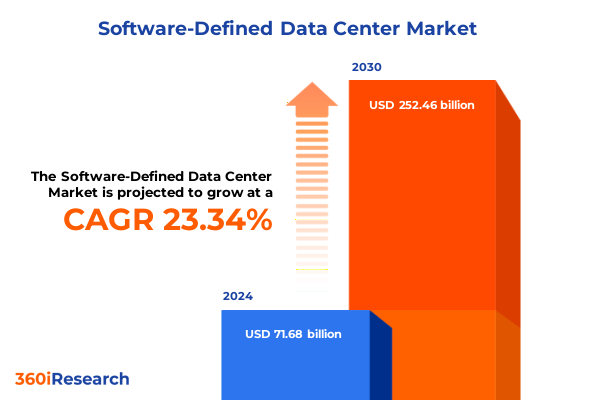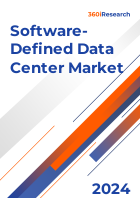The Software-Defined Data Center Market size was estimated at USD 71.68 billion in 2024 and expected to reach USD 89.05 billion in 2025, at a CAGR 23.34% to reach USD 252.46 billion by 2030.

Introduction to the Software-Defined Data Center Revolution
The Software-Defined Data Center (SDDC) represents the next evolution in enterprise infrastructure, delivering unmatched agility, scalability, and cost efficiency. By abstracting compute, storage, networking, and security functions into software layers, organizations can rapidly adapt to changing business demands while streamlining operations. This summary provides an authoritative overview of the key technological drivers, market dynamics, and strategic considerations that are shaping the SDDC landscape. It is tailored for CIOs, IT architects, financial executives, and strategic planners seeking to align their technology investments with evolving digital transformation objectives. Throughout this executive summary, readers will gain clarity on emerging shifts, regulatory impacts, and competitive forces, setting the stage for informed, forward-looking decisions.
Transformative Shifts Defining the SDDC Landscape
Over the past two years, the SDDC arena has witnessed pivotal transformations. Infrastructure virtualization has matured from server consolidation to full-stack orchestration, enabling seamless resource pooling and policy-driven management. Concurrently, automation frameworks, once confined to scripting tasks, now support end-to-end workflow orchestration across multi-cloud environments. Cloud-native design principles have infused containerization and microservices into traditional data center processes, accelerating application release cycles and reducing operational friction. Meanwhile, AI-powered analytics and intent-based networking have moved from pilot stages to production deployments, dynamically optimizing performance and security. Edge computing architectures have emerged to complement core SDDC deployments, bringing compute and storage closer to data sources and reducing latency for critical applications. Collectively, these trends are coalescing into a new paradigm where infrastructure is treated as code, policies are enforced through unified control planes, and data center assets respond adaptively to business intent.
Assessing the 2025 Tariff Impact on Infrastructure Costs
United States tariffs enacted through 2025 under Sections 232 and 301 have introduced material cost pressures across hardware components, semiconductor supplies, and supporting services. Steel and aluminum duties have elevated rack and enclosure expenses, while higher levies on imported server components have increased total cost of ownership. In response, many organizations are renegotiating vendor contracts, stockpiling critical components, and exploring alternative suppliers to mitigate price volatility. Service providers face margin compression as integration and deployment fees rise, prompting a shift toward value-added consulting engagements that emphasize efficiency gains. Moreover, data security and encryption solutions, heavily reliant on specialized hardware, confront longer lead times and pass-through tariffs, driving some enterprises to adopt software-only alternatives or repatriate development to domestic foundries. Overall, the cumulative tariff impact has accelerated the move to cloud-native, disaggregated architectures that minimize dependency on tariff-affected hardware while preserving performance and reliability.
Comprehensive Segmentation Insights into SDDC Adoption
Based on type, the SDDC market encompasses an array of consulting, integration and deployment, and training and support services, alongside a diverse solutions portfolio. Consulting engagements range from implementation strategy advisory to strategic business planning, ensuring that every phase of transformation aligns with organizational objectives. Integration and deployment offerings extend from comprehensive network setup to precision system configuration, delivering turnkey implementations. Training programs provide technical assistance and user instruction, empowering teams to operate and optimize SDDC environments. On the solutions side, automation systems orchestrate tasks and streamline workflows, while cloud management platforms enable hybrid-cloud optimization and multi-cloud governance. Computing management solutions facilitate dynamic resource allocation and server virtualization, and data security suites encompass access control management and advanced encryption technologies. When viewed through the applications lens, core sectors such as banking and financial services rely on customer data management and transaction security systems; government and defense demand resilient communication systems and secure data centers; healthcare depends on electronic health records management and telemedicine infrastructures; and telecommunications benefit from infrastructure optimization and network management solutions. From an end-user perspective, individual users gravitate toward private cloud solutions and virtual desktop infrastructures; large enterprises, including big tech corporations and Fortune 500 companies, deploy enterprise-grade SDDC platforms; and small and medium enterprises, such as local manufacturing firms and tech startups, adopt scalable, cost-effective packages. Industry verticals span IT and telecom with network function virtualization and unified communication solutions; manufacturing with smart factory management and supply chain optimization; and retail with e-commerce platforms and omnichannel customer engagement. Finally, the technology foundation comprises networking innovations in software-defined networking and NFV, storage advances in software-defined storage and data replication technologies, and virtualization breakthroughs across server, storage, and network domains.
This comprehensive research report categorizes the Software-Defined Data Center market into clearly defined segments, providing a detailed analysis of emerging trends and precise revenue forecasts to support strategic decision-making.
- Type
- Applications
- End-Users
- Industry Verticals
- Technologies
Key Regional Trends Shaping Market Dynamics
In the Americas, robust investment in digital transformation and strong enterprise demand have positioned North and South American markets as early adopters of SDDC solutions, especially in the financial services and healthcare sectors. Latin American organizations are increasingly leveraging container-based deployments to overcome infrastructure constraints. Europe, Middle East & Africa combine mature Western European markets pursuing compliance-driven SDDC modernization with emerging African and Gulf states harnessing software-defined platforms to leapfrog legacy hardware. Regulatory frameworks such as GDPR further catalyze adoption of native encryption and data governance capabilities. In the Asia-Pacific region, sustained economic growth and government-backed cloud initiatives in countries like India, China, Japan, and Australia have driven rapid SDDC uptake. Local technology giants partner with hyperscalers to deliver integrated automation and hybrid cloud offerings, while regional telcos deploy edge-centric architectures to support 5G-enabled services. Across all geographies, interoperability, local support ecosystems, and data sovereignty remain critical factors influencing deployment strategies.
This comprehensive research report examines key regions that drive the evolution of the Software-Defined Data Center market, offering deep insights into regional trends, growth factors, and industry developments that are influencing market performance.
- Americas
- Asia-Pacific
- Europe, Middle East & Africa
Insights into Leading SDDC Portfolio Strategies
Industry leaders such as Broadcom Inc., Check Point Software Technologies Ltd., Cisco Systems, Inc., and Citrix Systems, Inc. continue to push the envelope on network orchestration and virtualization standards. Established infrastructure vendors including Dell Technologies Inc., Extreme Networks, Inc., Fortinet, Inc., and Fujitsu Limited focus on delivering end-to-end security frameworks and high-performance computing platforms. Global technology powerhouses Hitachi, Ltd., Huawei Technologies Co., Ltd., IBM Corporation, Juniper Networks, Inc., and Lenovo Group Ltd. invest heavily in hybrid and multi-cloud management capabilities. Meanwhile, software and storage specialists Microsoft Corporation, NetApp, Inc., Palo Alto Networks, Inc., Pure Storage, Inc., Rackspace Technology, Inc., Riverbed Technology, Inc., SUSE S.A., Trend Micro Incorporated, and Veritas Technologies LLC emphasize managed services, data protection, and software-defined storage solutions. Collectively, these companies drive competitive differentiation through integrated toolsets, partner ecosystems, and ongoing innovation roadmaps.
This comprehensive research report delivers an in-depth overview of the principal market players in the Software-Defined Data Center market, evaluating their market share, strategic initiatives, and competitive positioning to illuminate the factors shaping the competitive landscape.
- Broadcom Inc.
- Check Point Software Technologies Ltd.
- Cisco Systems, Inc.
- Citrix Systems, Inc.
- Dell Technologies Inc.
- Extreme Networks, Inc.
- Fortinet, Inc.
- Fujitsu Limited
- Hitachi, Ltd.
- Huawei Technologies Co., Ltd.
- IBM Corporation
- Juniper Networks, Inc.
- Lenovo Group Ltd.
- Microsoft Corporation
- NetApp, Inc.
- Palo Alto Networks, Inc.
- Pure Storage, Inc.
- Rackspace Technology, Inc.
- Riverbed Technology, Inc.
- SUSE S.A.
- Trend Micro Incorporated
- Veritas Technologies LLC
Actionable Recommendations for SDDC Leadership
To capitalize on the SDDC opportunity, industry leaders should pursue a multi-pronged approach. First, standardize on open, API-driven architectures to accelerate interoperability between virtualization platforms, cloud environments, and security controls. Second, invest in automation frameworks that extend beyond infrastructure provisioning to incorporate policy enforcement, compliance auditing, and anomaly detection. Third, forge strategic alliances with hyperscalers, managed service providers, and niche technology vendors to broaden solution portfolios and address end-to-end customer requirements. Fourth, embed advanced security and encryption mechanisms at every layer, ensuring data integrity and regulatory compliance across hybrid and edge deployments. Fifth, develop in-house capabilities through targeted training and certification programs, enabling teams to architect, deploy, and manage SDDC environments with minimal external dependency. Lastly, integrate predictive analytics and AI-driven operations to optimize resource utilization, forecast capacity needs, and proactively mitigate performance bottlenecks.
Explore AI-driven insights for the Software-Defined Data Center market with ResearchAI on our online platform, providing deeper, data-backed market analysis.
Ask ResearchAI anything
World's First Innovative Al for Market Research
Conclusion: Embracing the Future of Data Center Infrastructure
The Software-Defined Data Center represents a strategic imperative for organizations seeking to maintain competitive agility, reduce operational complexity, and safeguard critical assets. By embracing virtualization, automation, and unified management, enterprises can transition from rigid, hardware-centric infrastructures to dynamic, software-driven ecosystems that align with evolving business objectives. The convergence of AI-powered operations, edge computing, and robust security frameworks will further solidify the SDDC as the cornerstone of modern IT strategies. As market forces continue to reshape procurement models and regulatory landscapes evolve, stakeholders must prioritize architectural flexibility, partner collaboration, and talent development. Ultimately, a disciplined, phased approach to SDDC adoption will unlock significant efficiency gains, cost savings, and innovation potential.
This section provides a structured overview of the report, outlining key chapters and topics covered for easy reference in our Software-Defined Data Center market comprehensive research report.
- Preface
- Research Methodology
- Executive Summary
- Market Overview
- Market Dynamics
- Market Insights
- Cumulative Impact of United States Tariffs 2025
- Software-Defined Data Center Market, by Type
- Software-Defined Data Center Market, by Applications
- Software-Defined Data Center Market, by End-Users
- Software-Defined Data Center Market, by Industry Verticals
- Software-Defined Data Center Market, by Technologies
- Americas Software-Defined Data Center Market
- Asia-Pacific Software-Defined Data Center Market
- Europe, Middle East & Africa Software-Defined Data Center Market
- Competitive Landscape
- ResearchAI
- ResearchStatistics
- ResearchContacts
- ResearchArticles
- Appendix
- List of Figures [Total: 26]
- List of Tables [Total: 1207 ]
Call-To-Action: Secure Your Detailed SDDC Market Report Today
To secure a tailored market research report that delves deeper into these insights and equips your organization with the data needed to drive strategic decisions, please reach out to Ketan Rohom, Associate Director, Sales & Marketing, via email or telephone. Engage now to gain exclusive access to comprehensive analysis, detailed case studies, and expert recommendations that will empower your SDDC journey.

- How big is the Software-Defined Data Center Market?
- What is the Software-Defined Data Center Market growth?
- When do I get the report?
- In what format does this report get delivered to me?
- How long has 360iResearch been around?
- What if I have a question about your reports?
- Can I share this report with my team?
- Can I use your research in my presentation?




